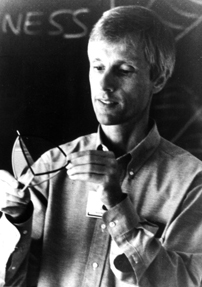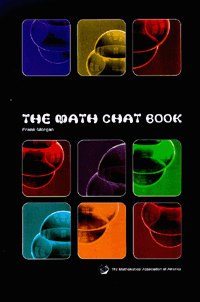- About MAA
- Membership
- MAA Publications
- Periodicals
- Blogs
- MAA Book Series
- MAA Press (an imprint of the AMS)
- MAA Notes
- MAA Reviews
- Mathematical Communication
- Information for Libraries
- Author Resources
- Advertise with MAA
- Meetings
- Competitions
- Programs
- Communities
- MAA Sections
- SIGMAA
- MAA Connect
- Students
- MAA Awards
- Awards Booklets
- Writing Awards
- Teaching Awards
- Service Awards
- Research Awards
- Lecture Awards
- Putnam Competition Individual and Team Winners
- D. E. Shaw Group AMC 8 Awards & Certificates
- Maryam Mirzakhani AMC 10 A Awards & Certificates
- Two Sigma AMC 10 B Awards & Certificates
- Jane Street AMC 12 A Awards & Certificates
- Akamai AMC 12 B Awards & Certificates
- High School Teachers
- News
You are here
Frank Morgan's Math Chat - Russian Roulette
 |
 |
March 15, 2001
Old Challenge (Al Zimmermann). In Russian Roulette, five of the six chambers of a water gun are empty, and the sixth is loaded with whipped cream. Two players take turns spinning the chambers of a gun and firing at themselves, hoping to stay clean. The second player has a decided advantage. How can the game be modified so that each player has an equal chance of winning?
Answer. Bending the rules a bit, Jonathan Falk, Nathan Wright, and John George suggest beginning the game with a coin toss to see who goes first. Similarly, many readers note that if only the first player spins the chambers, the game becomes fair; each round each has a 1/6 chance of winning. Alex Glasser notes that the original game becomes fair if the first player fills two chambers each time he goes, and the second player fills three chambers each time he goes. Then each round the first player has a 2/6 = 1/3 chance of whipped cream, while the second player has a 2/3 chance of going times a 2/6 = 1/2 chance of whipped cream, i.e., an identical 1/3 chance of whipped cream.
Without bending the rules, Todd Feitelson provides two very interesting solutions which come very close to fair (within a thousandth of a percent): (1) Player 1 takes all the odd turns except for turns 9, 19, 35, and 43. (2) Player 2 takes only turns 1, 2, 3, 7, 12, 33. Feitelson thinks that Solution (2) "is wackier, so I like it better. Picture sitting and getting by those first five turns, only to get whipped creamed on the 33rd turn. Okay, it only will happen 1 out of 2000 games, but what a story you'll have. Alternately, think of being the other guy having to sit from turns 34 to infinity firing until the whipped cream comes out. Sure, he could just quit, but I like to think that honor is still alive among people who play hypothetical games."
Falk goes farther to get a "scheme which comes as close as my computer can calculate these things: have player 2 go on turns 4-13,15,26,48,78,91,111,126,137,149,165,175,188,202,214,227,249,262, and have player 1 go on the other turns."
Al Zimmermann suggests that with whipped cream the game should perhaps be called Belgian Roulette (like Belgian waffles).
Old Riddle (Alex Glasser). Is there something amiss in the opening of O. Henry's famous Christmas story, "The Gift of the Magi":
"One dollar and eighty-seven cents. That was all. And sixty cents of it was in pennies...Three times Della counted it. One dollar and eighty-seven cents. And the next day would be Christmas."
Answer (Joseph DeVincentis). No, there's not necessarily anything amiss. The US produced a 2-cent coin for general circulation up until 1872 and a 3-cent coin until 1889. Either of these would allow the math to work out OK. John Sullivan notes that there were also half-cent pieces produced from 1794 until 1857, which might still have been in circulation. (DeVincentis, John Shonder, and Eric Brahinsky recommend websites at geocities, coco, and oldcoinshop.) William Sidney Porter (O. Henry) lived from 1862 to 1910. The story was first published in 1906.
New Challenge (John George). Each year a kingdom mints one million new coins, and a random ten percent of all old coins are destroyed. About how old do you expect the oldest coin in circulation to be?
Send answers, comments, and new questions by email to Frank.Morgan@williams.edu, to be eligible for Flatland and other book awards. Winning answers will appear in the next Math Chat. Math Chat appears on the first and third Thursdays of each month. Prof. Morgan's homepage is at www.williams.edu/Mathematics/fmorgan.
THE MATH CHAT BOOK, including a $1000 Math Chat Book QUEST, questions and answers, and a list of past challenge winners, is now available from the MAA (800-331-1622).
Copyright 2001, Frank Morgan.




